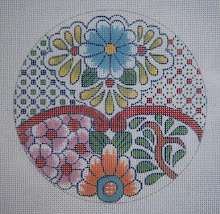 I can't possibly stitch an ornament to demonstrate this, as time is a factor - so am just showing it with a shaped outline, as the process can be easily demonstrated this way.
I can't possibly stitch an ornament to demonstrate this, as time is a factor - so am just showing it with a shaped outline, as the process can be easily demonstrated this way. I'm using two outline forms that I used to use for teaching beginners - back when we taught basketweave as the basic for fine stitching. People had to learn to stitch outlines within a design, and also odd shapes, as they needed to learn the concept of the outline stitch and having all the "tent stitches" going the same way on the canvas.
Another way I use outlines also is to enclose an irregular shape within a design on a painted canvas when it is to be stitched with textured stitches and adjacent to another area, to eliminate ragged and unattractive edges. It makes the stitching sooo much easier! Also - on any ornament, as on my circles with bargello. Leaves no doubt as to where to begin and end "fancy" stitches.

The second pictures is horribly blurry, but I had already started stitching the background before I unloaded it from the camera - but you can see where I marked three threads out wherever I could when t
 he stitches were on the straight vertical or horizontal. After that, it's a matter of "connecting the dots" to draw the outline for the background.
he stitches were on the straight vertical or horizontal. After that, it's a matter of "connecting the dots" to draw the outline for the background. As I've said, a really competent finisher doesn't need more than about two extra rows. Many designers don't add this, and I've seen stitchers and shop owners perplexed when part of the design was lost in the finishing - so I've made a point for many years of drawing the outline around the piece myself. I like the three rows, as with the light padding in the finishing, it leaves a slight bit of color around the design - kind of like a mat liner when framing a picture.

The next picture illustrates how to find where to start this basketweave background.
If you've learned properly, you will already know that one stitches UP on the weft (horizontals) and DOWN on the warp (the little bumps). This is vital to a really nice stitched surface - and also is a great way to understand where to start and stop.
The piece of paper is at a 45 degree angle, so that one can see whether the first row of stitches is warp or weft. In this case, you can clearly see (click to enlarge the picture) that the row just under the paper is WARP, so the first stitches on the curve w
 ill be on the weft where the arrow is pointing.
ill be on the weft where the arrow is pointing.On the next picture, the stitching is begun, and the arrow at the top shows the weft threads where I'll start again after going down the right side. The lower arrow points to where the next thread will begin the stitches, as it's not a straight line from that curve up to where I stopped the stitching. This way, stitching up the weft will happen with no breaks - and again, the surface will be smooth.

This second shape is a bit more complicated - and will illustrate some common mistakes people make in stitching odd areas, like the "V" at the top. This one is at the "dot" stage, and then the dots will be connected for the background outline. The arrows point to mistakes I made, which I will dot out with white acrylic - or just make the adjustment with my needle and thread when I get there.

This is a choice we make when stitching - and is part of the art. We need to be able to judge whether a stitch is right to make the curve look pretty, or should not be done.
This is also a plus for the well painted canvas, that there seem to be too few of these days. The choices of where to place a stitch shouldn't be difficult.
 On the last picture, the arrows point to where the next threads will be started.
On the last picture, the arrows point to where the next threads will be started.More about stitching in the next post - this is enough of my "pontificating" for one day.

No comments:
Post a Comment